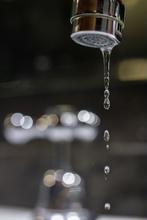History of Plumbing Research at NIST
Hoover Codes Hunter's Curves Plumbing Tower
Appliance Efficiency Decontamination Field Data
Hoover Codes
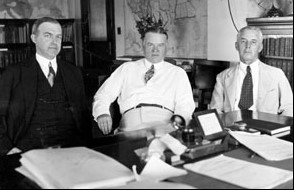
The introduction of plumbing systems into buildings constituted a tremendous advance in public health, safety, and comfort. However, a number of challenges arose in the building sector following World War I, including the need for more uniformity in local building and plumbing codes. These challenges led Secretary of Commerce Herbert Hoover to create in 1921 a building and housing division within the National Bureau of Standards (NBS), the predecessor to the National Institute of Standards and Technology. Motivations for this new division included “poor home designs, high labor and material costs, antiquated and obstructive building codes and zoning regulations” (Cochran, 1966).
Specific to plumbing, system failures and contamination were among the many challenges facing premise plumbing in the late 19th and early 20th century. For example, very little was known about how building occupants used water, unnecessarily restrictive code requirements were expensive to implement, and health and safety concerns were not being adequately addressed (Whipple, et al., 1924).
In that 1924 report, Secretary Hoover stated “Actual practice has been governed by opinions and guesswork, often involving needless costly precautions which many families could ill afford. The lack of generally recognized principles is responsible to a certain extent for the contradictory plumbing regulations in different localities.” To help industry become more profitable and efficient, he organized a group of industry experts to form the Department of Commerce’s Building Code Committee to help address the chronic problems with premise plumbing systems. When they found that minimum requirements could not be determined from existing codes, Secretary Hoover called for NBS to conduct experiments to investigate the underlying principles of house drainage under the supervision of a subcommittee of sanitary engineers and plumbers.
As a result, the first plumbing code was published in 1928, commonly referred to as the Hoover Report or Hoover Code (Whipple, et al., 1928). This prescriptive code established 20 basic principles of plumbing systems as well as minimum technical requirements to achieve safe and healthy systems. Many engineers, plumbing inspectors, plumbers, and architects provided data and reviewed recommendations in the development of this code.
References:
- Cochran, R.C. (1966) Measures for Progress, Washington DC, National Bureau of Standards.
- Whipple, G.C., Carson, H.Y., Hanley, T.F., Groeninger, W.C., Hansen, A.E., Gries, J.M., Cartwright, F.P. and Hunter, R.B. (1924) Recommended Minimum Requirements for Plumbing in Dwellings and Similar Buildings, Washington DC, National Bureau of Standards.
- Whipple, G.C., Carson, H.Y., Hansen, A.E., Groeninger, W.C., Murphy, W.C., Gries, J.M., Thompson, G.N. and Hunter, R.B. (1928) Recommended minimum requirements for plumbing: report of subcommittee on plumbing of the building code committee, Washington DC, National Bureau of Standards.
Hunter's Curves
Plumbing designers frequently use “Hunter’s Curves” as part of the plumbing design process. These curves help designers assess the expected maximum flow rate for which they need to design a building’s plumbing system. The curves, as shown below, give a relationship between the number of “fixture units” in a building and the maximum flow rate that would be expected in that building. A “fixture unit” is a unit of measure that estimates the water load that a fixture would put on a plumbing system based on its flow rate and frequency of use. Since it would not be expected that all fixtures in a building would be used at the same time, the curves incorporate the probability of use.
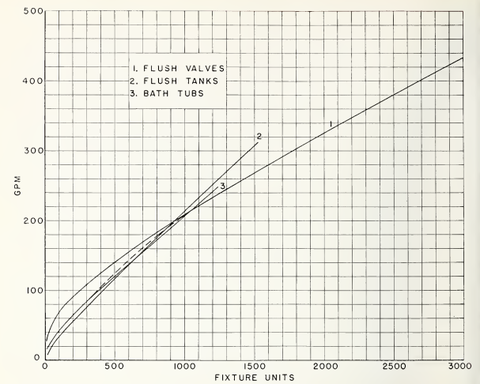
These curves were developed by NBS Researcher Dr. Roy Hunter in the first half of the 20th century and are presented in his seminal publication from 1940 (Hunter, 1940). From limited actual building usage patterns, data, and extended laboratory research, Hunter presented the load producing values of different types of plumbing fixtures and from that developed curves that estimate the number of fixtures most likely to be operating simultaneously as a function of the total number of fixtures in the design. This determination established the necessary piping requirements for both supply and discharge.
References:
Hunter, R.B. (1940) Methods of estimating loads in plumbing systems, Washington DC, National Bureau of Standards.
Plumbing Tower
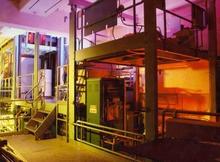
In the 1970’s, the drive to develop performance standards and to foster international collaboration in plumbing research led to the construction of plumbing research facilities. In 1972, the National Bureau of Standards erected a 5-story plumbing tower in Gaithersburg, Maryland to study the performance of plumbing fixtures, as well as water supply, drainage and venting issues (Wright, 2003 ). The tower was used intermittently into the 1980s for plumbing related research and was decommissioned in 2005.
Appliance Efficiency Test Methods
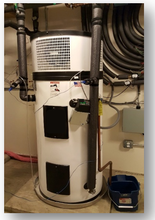
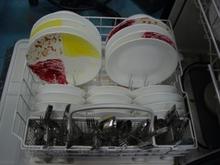
Since the 1970s, NIST has been heavily involved in the development of test methods to assess the energy and water efficiency of appliances in conjunction with the Department of Energy. Of note, NIST has worked on test methods for water heaters, dishwashers, clothes washers, and water closets. In addition to its work with DOE, NIST has taken an active role in the development of test methods through industry-led Standards Developing Organizations, such as ASHRAE Standard 118.2 (Method of Testing for Rating Residential Water Heaters and Residential-Duty Commercial Water Heaters), ASHRAE Standard 118.1 (Method of Testing for Rating Commercial Gas, Electric and Oil Service Water Heating Equipment), and ASHRAE Standard 146 (Methods of Testing and Rating Pool Heaters).
Decontamination
NIST worked with the U.S. Environmental Protection Agency in the early 2000’s to assess the accumulation and removal of contaminants in building plumbing systems. Experimental work was conducted to examine methods for decontamination and simulation models were developed to predict maximum contamination levels and required flushing times. A report documenting recommendations is available here.
Field Data Collection Protocols
